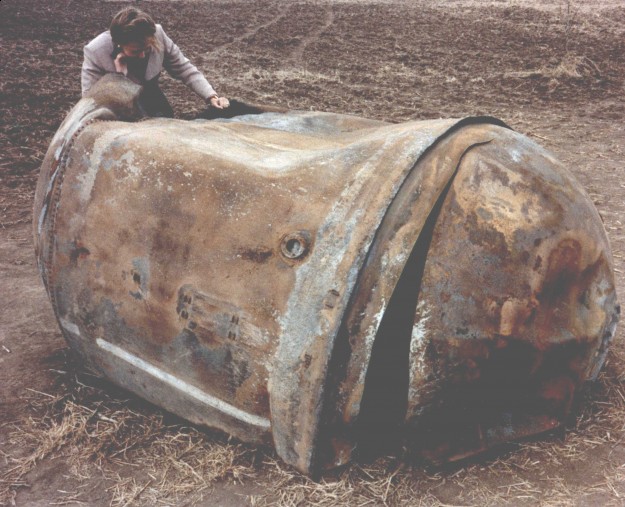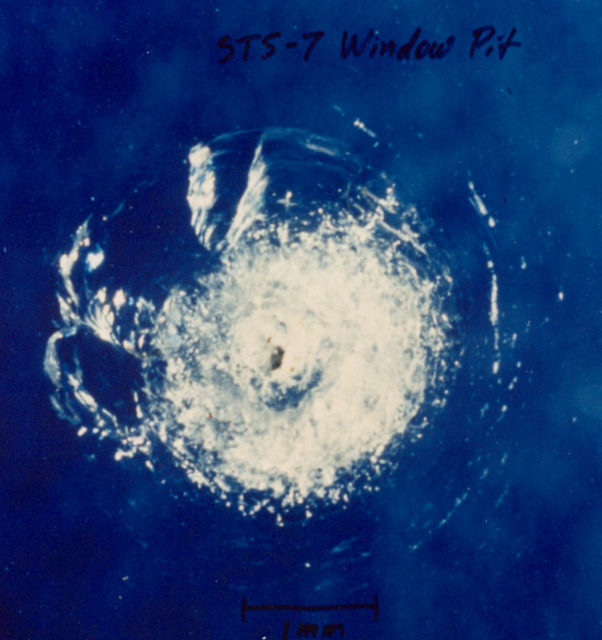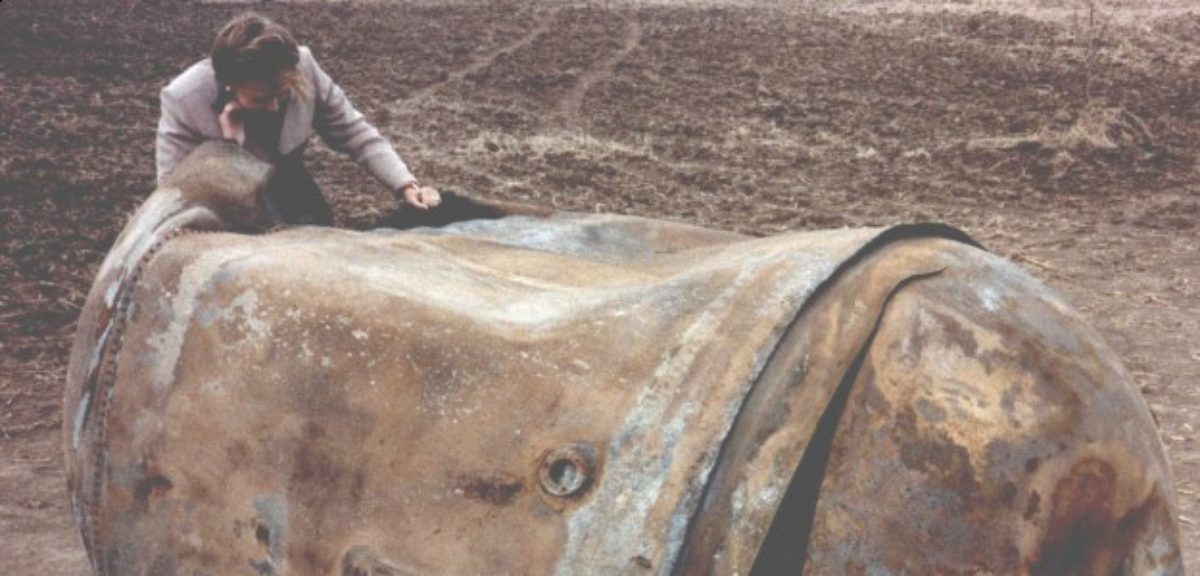
Computer generated image of Earth’s orbitral debis. View is from a distant oblique vantage point to provide a good view of the object population in the geosynchronous region – around 35,785 km altitude. (NASA)
Scientists estimate that there are some 750,000 pieces of space junk circling Earth, millions more if you count fragments smaller than 1 centimeter.
Think about it: Mankind has sent thousands of rockets into space since the launch of the first satellite, Sputnik 1, in 1957.
While a number of space vehicles are still in active orbit around our planet, many have since dropped from orbit and destroyed by the burning friction of reentering Earth’s atmosphere. Some of that falling debris fell to Earth in chunks.

Delta 2nd Stage Stainless Steel Cylindrical Propellant Tank; landed in Georgetown, TX (NASA Orbital Debris Program Office)
To make matters worse, over the years satellites have exploded, collided, or simply just disintegrated, leaving a thick trail of fragments.
According to NASA, most of the space junk is located within 2,000 kilometers above Earth.
Small but potentially deadly
Some pieces of space junk are as small as a fleck of paint.
But despite its tiny size, a fleck of paint flying at average impact speeds of 10 kilometers per second could still severely damage an active spacecraft or even worse, an astronaut performing extravehicular activity (EVA) also known as a spacewalk.
The 2013 film “Gravity”, stars Sandra Bullock as an astronaut aboard a space shuttle, shows a fictional but terrifying worst case scenario of the effects of space junk.
In the movie, a Russian satellite explodes, hurling fast moving chunks of debris that destroys her spacecraft. Her character was outside the spacecraft performing an EVA at the time of the catastrophic collision.
The film follows her struggle to survive and return to Earth aboard a Chinese capsule that had been docked at a space station before it too was destroyed by space junk.

This film image released by Warner Bros. Pictures shows Sandra Bullock in a scene from “Gravity.” (AP Photo/Warner Bros. Pictures, File)
Tracking space trash
In recent years a number of space agencies around the world have called for tackling the growing problem of space debris.
In the United States, NASA’s Orbital Debris Program (ODP) at the Johnson Space Center in Texas, keeps an eye on the ever-expanding junkyard of space.
Large pieces of space junk, more than 10 centimeters, are routinely tracked by the U.S. Space Surveillance Network.
Founded in 1993, the Inter-Agency Space Debris Coordination Committee (IADC) is an intergovernmental agency that coordinates the efforts of space agencies from around the world to deal with issues related to both natural and man-made space debris.
The European Space Agency (ESA) recently hosted 350 participants at the European Conference on Space Debris in Germany.
Conference participants stressed an urgent need for coordinated international action.

A tiny piece of space junk (a paint fleck) damaged the window of the space shuttle during the STS-7 mission (NASA Orbital Debris Program Office)
Adding to the clutter
Meanwhile, Hugh Lewis, Senior Lecturer in Aerospace Engineering at Southampton University in the UK, told conference participants the launch of the first ‘mega-constellations’ of tiny communications satellites, called CubeSats, within the next year will increase the risk to Earth’s space environment unless action is taken to reduce their impact.
As part of efforts to provide high-speed internet throughout the world, Boeing, OneWeb and SpaceX are among several companies that have submitted plans to launch constellations of 720 to 4,425 of these tiny CubeSats as early as next year.
A team of engineers using the University of Southampton’s space debris model and its high performance computing facility were able to simulate the impact and effects of the deployment of large groups of CubeSats and small satellites over a 200-year period.
Their model showed the CubeSats would cause a 50% jump in the number of disastrous collisions that could result in serious consequences for other satellites.
The engineers’ suggested solutions include:
- Decreasing the time that satellites spend in low Earth orbit after the end of their mission.
- Making satellites smaller and more lightweight
- Adding propulsion systems and other features to small satellites
- Extending a satellite’s active lifespan to reduce the number that would need to be launched.
- Deploying missions to remove faulty satellites from orbit























Keeping space clean from orbiting junk, waste, and garbage while driving innovation to meet the emerging needs of waste management and recycling in space development! http://www.spacewastesolutions.com